Did you know?
Many BarnOwl audit clients are not aware of the value that the ‘Project Registers’ can provide especially when configured with favourite views. Registers can be viewed globally as well for a specific unit or a process. Global means that a user can view information across the entire organisational structure and process structure (or part thereof) as opposed to views based on single units and / or processes. The ‘Project Listing’ navigation bar is used for global views. Alternatively use the ‘Organisational Structure’ navigation bar or ‘Process Tree’ navigation bar to view projects specific to a unit or a process. Permissions are always applied which ensures that a user (auditor) can only see his / her audit projects unless he / she has group or admin rights to view all projects.
The following is a brief summary of the various audit registers utilising standard and favourite views:
Fig 1.1 Default Project Listing register
Fig 1.2 Project Listing using a favourite view with a filter to exclude ‘completed’ and ‘closed’ projects and sorted by descending project start date
Fig 1.3 Project Listing: Audit Projects grouped by ‘child’ table Unit
Fig 1.4 Project Listing: Audit Projects grouped by ‘child’ table Resource
Fig 2.1 Project Plan Register
Fig 3.1 Projects by Resource by Task showing planned and actual hours
Fig 4.1 Projects by Resource by Task showing planned and actual hours and progress (% Complete per task)
Fig 5.1 Project Plans and Projects by timeline on a Gantt chart showing % complete
Fig 6.1 Audit Objective Register
Fig 7.1.1 Findings Register (global)
Fig 7.1.2 Findings Register (unit specific)
Fig 7.2.1 Findings by Responsible Owner by Action Plan Due Date (incomplete Action Plans only) (global)
Fig 7.2.2 Findings by Auditor by Finding Rating (incomplete Action Plans only) (unit specific)
Fig 7.3.1 Global Finding Register for Johannesburg (and child units) grouped by finding rating
Fig 8.1 View>Scorecards>Process versus Unit Project scorecard
Fig 9.1 View>Document Register
Project Listing navigation bar
Some Views are only available in the ‘Project Listing’ navigation bar:
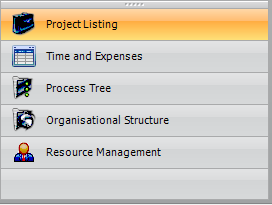
View > Project Register
The project listing register enables you to very quickly see which projects you are allocated to and the status of the project. You can click on the toggle to ‘Show All Projects’ / ‘Show My Projects’.
Permissions are still applied which ensures that a user (auditor) can only see his / her audit projects unless he / she has group or admin rights to view all projects. Effective use of favourite views can give you the information you require at the click of a button:
Fig 1.1 Default Project Listing register
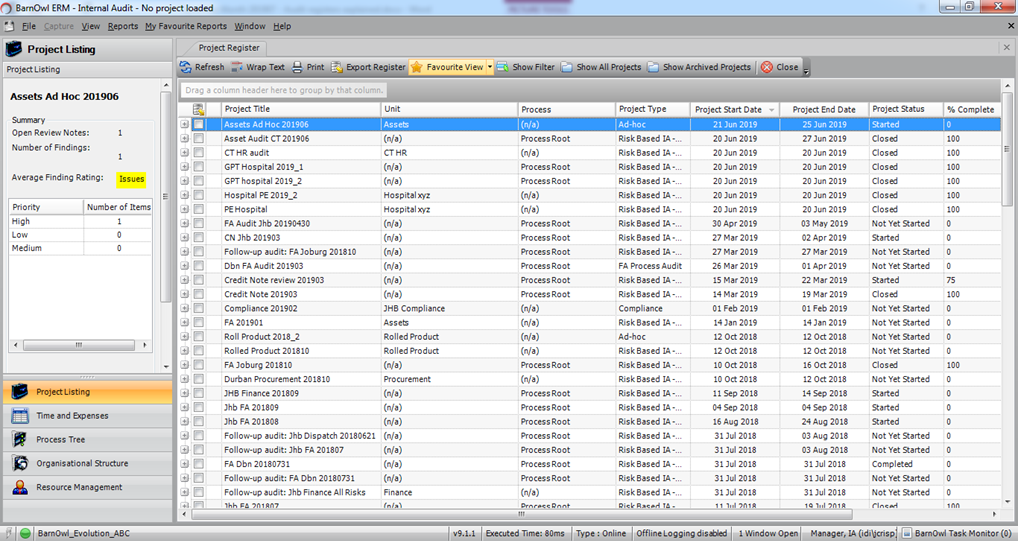
The above view shows all projects sorted by ‘Project End Date’ in descending order including the project status and % complete. It is possible to save multiple favourite views so that you can view the relevant information at the click of a button. You can also share favourite views with other users.
Note: It is possible to sort by multiple fields (columns) by holding the ‘shift’ key down and selecting the columns that you wish to sort by either ascending or descending. This is in addition to being able to drag a field/s (column) to the ‘Drag a header column here to group by that column’. You can even group by ‘child’ table columns such as the example in Fig 1.3 and 1.4 below. Grouping, sort order and filters can all be saved as favourite views.
For information about setting up Favourite Views, click here.
1.2 Project Listing using a favourite view with a filter to exclude ‘completed’ and ‘closed’ projects and sorted by descending project start date:
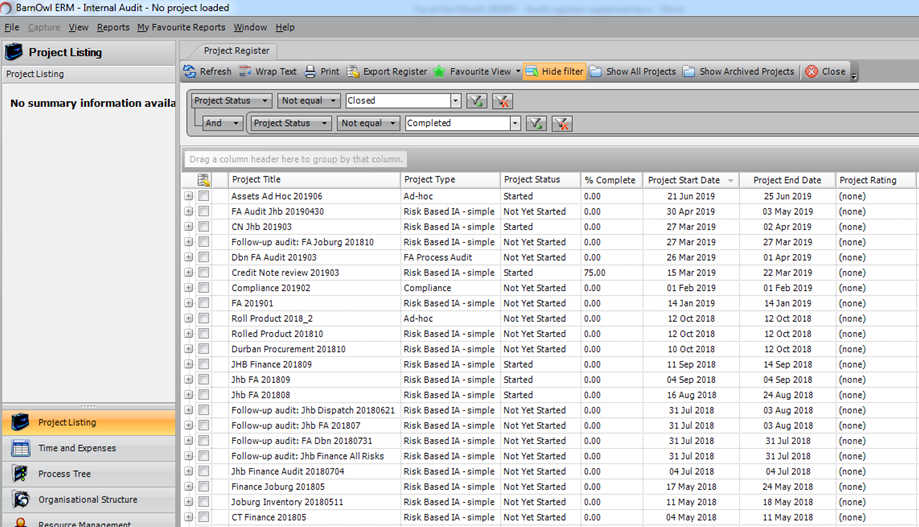
Fig 1.3 Project Listing: Audit Projects grouped by ‘child’ table Unit:

Fig 1.4 Project Listing: Audit Projects grouped by ‘child’ table Resource:

Expanded to show planned hours and actual hours per task within a project and the % complete per task. This helps you track the progress within each project. If you do not find the project you are looking for please see ‘resource type’ note in section 3.1 below.
View > Project Plan Register
It is possible in BarnOwl to capture audit project plans and to create audit projects under a plan. You can see all project plans and the relevant time allocated to individual projects within the plan. Alternatively, if you do not want to use project plans you can create audit projects directly (including start dates for the year ahead in advance) with a status ‘not yet started’ and you can view all projects in the ‘Project Listing register’ or in the ‘Project Plan Timeline’ register.
Fig 2.1 Project Plan Register

Showing ‘2016 Procurement’ project plan expanded to show the audit projects within the plan (i.e. 2016 Procurement CT and Procurement 2016 Jhb) and the audit tasks showing planned hours sorted by Unit and Task Title. You will note that if you name your tasks prefixed by digits (01, 02, 03…), you can sort your tasks in the correct order.
View > Project Resource Register
Fig 3.1 Projects by Resource by Task showing planned and actual hours
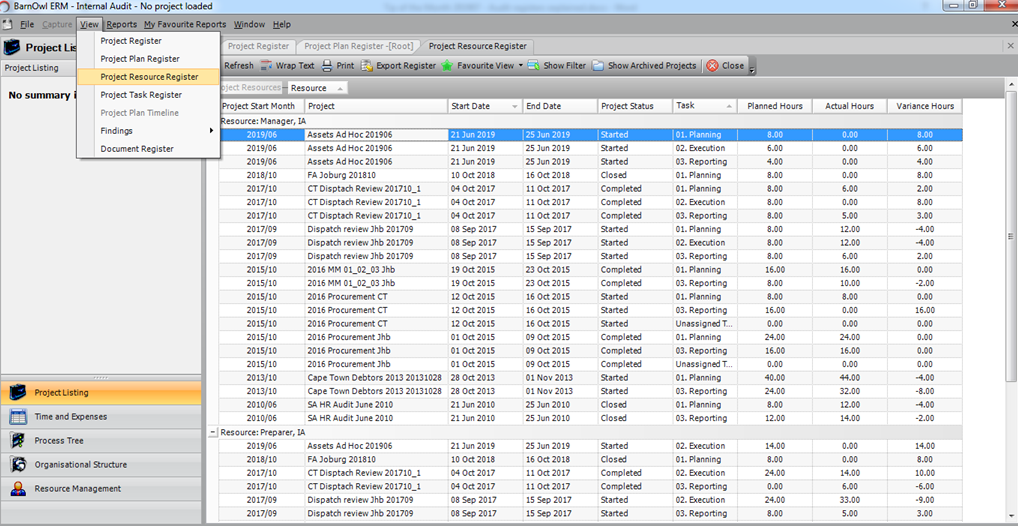
Note: ‘Resource Type’: if the resource type is not set per resource in the audit project, then the project will not display in this register. To set the resource type, load the relevant project and select View > Project detail > Allocation Register. Double click on each resource to edit the resource and complete the resource type.


The same applies to the timesheets (Time and Expenses tab). If the resource type is missing, the project will not display.
Alternatively, a more permanent solution is to ask your system administrator to set the resource type in the ‘Server Management Console’ (SCM) for each auditor as below. In this way, the resource type will always default to what it is set to in SCM:

View > Project Task Register
Fig 4.1 Projects by Resource by Task showing planned and actual hours and progress (% Complete per task)

If you do not find the project you are looking for please see ‘resource type note below figure 3.1 above.
Organisational Structure or Process Tree navigation bar
All Views (including the ones mentioned above) are available in the Organsational Structure navigation bar or the Process Tree navigation bar:

View > Project Plan Timeline Register
Fig 5.1 Project Plans and Projects by timeline on a Gantt chart showing % complete
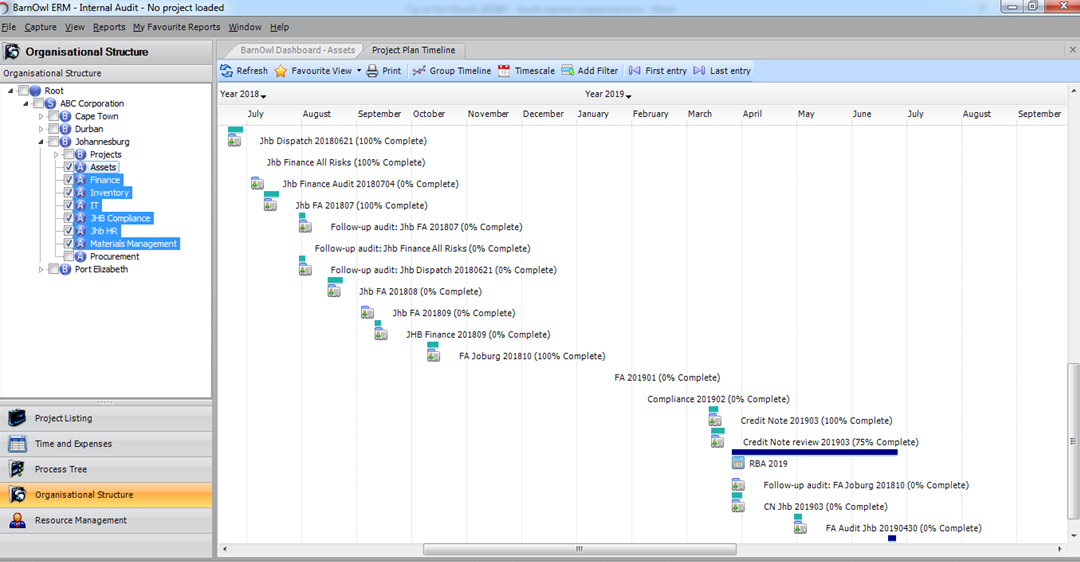
To see the ‘Project Plan Timeline’ you need to navigate to the ‘Organsational Structure’ navigation bar or the ‘Process Tree’ navigation bar. You can click on the unit/s that you wish to view a project timeline for by clicking on the unit in the l.h.s. pane. You can select multiple units by holding down the <Ctrl> key and clicking the relevant units.
You can use the  buttons to navigate to first and last entry of projects. You may need to scroll down to see your projects. The dark blue bars indicate ‘Project Plans’ and the light blue bars indicate audit projects. You are able to double click on a project to open the Project Plan or the individual Project.
buttons to navigate to first and last entry of projects. You may need to scroll down to see your projects. The dark blue bars indicate ‘Project Plans’ and the light blue bars indicate audit projects. You are able to double click on a project to open the Project Plan or the individual Project.
You can also play around with the  to customise your view/s and save as a favourite view.
to customise your view/s and save as a favourite view.
The  button exports the Gantt chart to a pdf document for a selected date range or projects. Filters can also be added by clicking the
button exports the Gantt chart to a pdf document for a selected date range or projects. Filters can also be added by clicking the  button.
button.
View > Audit Objective Register
This is menu option is only available in the ‘Process Tree’ navigation bar. This enables you to view and / or create new audit objectives and link relevant risks (pulled through from the process in RM) to the audit objective. This is normally done by an administrator / audit manager in the RM module when setting up the process library however can also be done in the audit module as mentioned here.
Note: If you forget to create and audit objective here or in RM it is also possible to capture a new audit objective within an audit project and drag the risks under the audit objective to link them.
Note: An audit objective is not related at all to the business ‘Objective’ in RM.
Fig 6.1 Audit Objective Register

Right click in the r.h.s panel to capture a new audit objective or link existing risks (pulled through from this process in RM) to this audit objective.
Project Listing, Process Tree and Organisational Structure navigation bars
View > Findings > Findings Register
Fig 7.1.1 Findings Register (global)
When on the ‘Project Listing’ navigation bar this view shows all findings in the database. The following is an example of findings grouped from most serious to least serious:

Fig 7.1.2 Findings Register (unit specific)
The same register and favourite view applied as above but for the ‘Finance’ unit only:
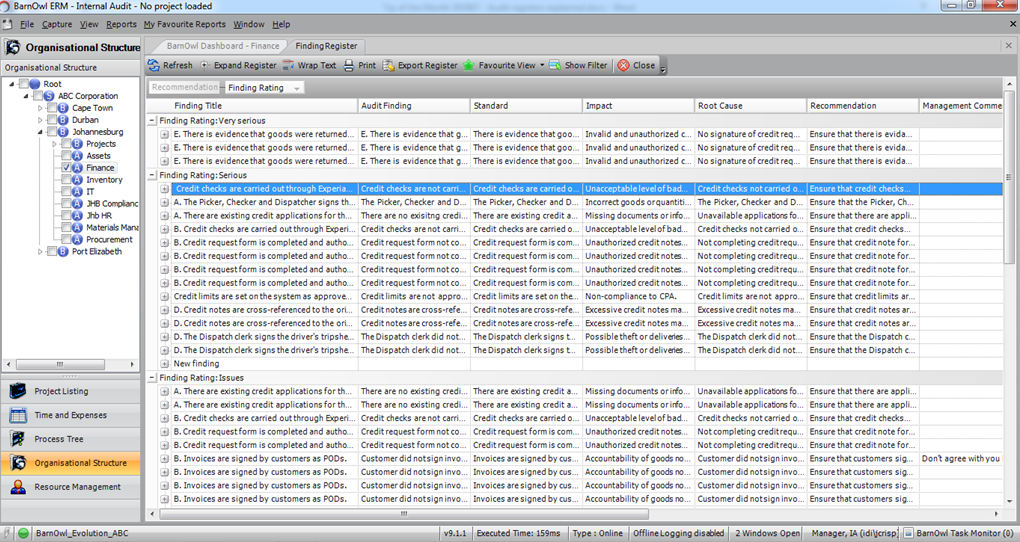
View > Findings > Flat Finding Register
This is a most useful register for follow-up of action plans on findings. It’s called a ‘flat’ register because it displays findings and action plans on a single row enabling you to group, sort and filter findings (with action plans) by action plan owner type (Accountable, responsible, consulted, informed, as well as where you (the auditor) are the originator).
Fig 7.2.1 Findings by Responsible Owner by Action Plan Due Date (incomplete Action Plans only) (global)
When on the ‘Project Listing’ navigation bar this view shows all findings in the database.

Fig 7.2.2 Findings by Auditor by Finding Rating (incomplete Action Plans only) (unit specific)
The same register as above but for the ‘Finance’ unit only with a different favourite view:
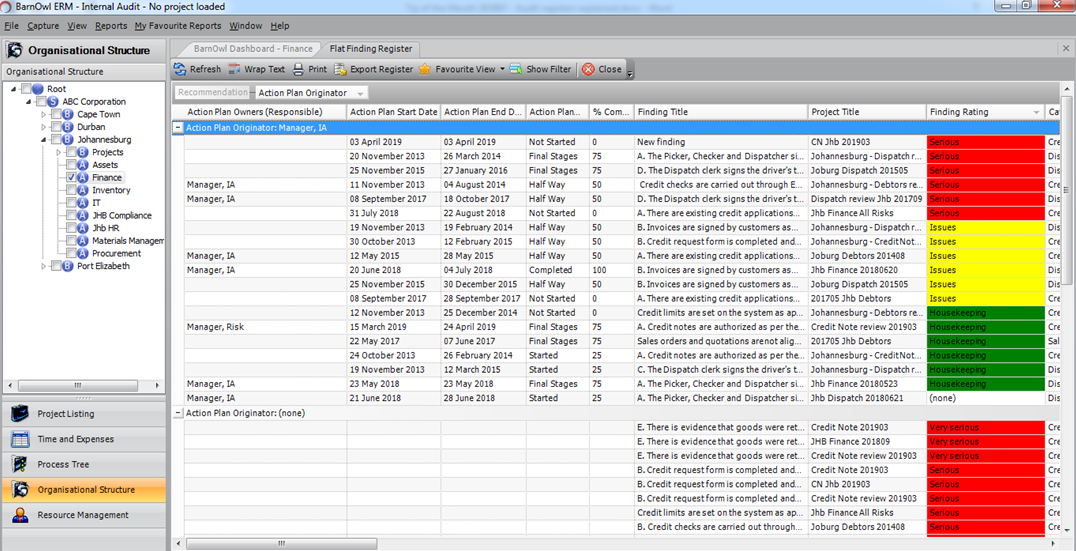
Process Tree and Organisational Structure navigation bars
View > Findings > Global Finding Register
The Global Finding Register is only available when either the ‘Process Tree’ navigation bar or ‘Organisational Structure’ navigation bar is selected. This is great way to view all findings at a regional / divisional level and all child units below. The following example shows all findings for the Johannesburg region grouped by finding rating from most serious to least serious. You can also double-click on a finding to open the finding in read-only mode.
Fig 7.3.1 Global Finding Register for Johannesburg (and child units) grouped by finding rating
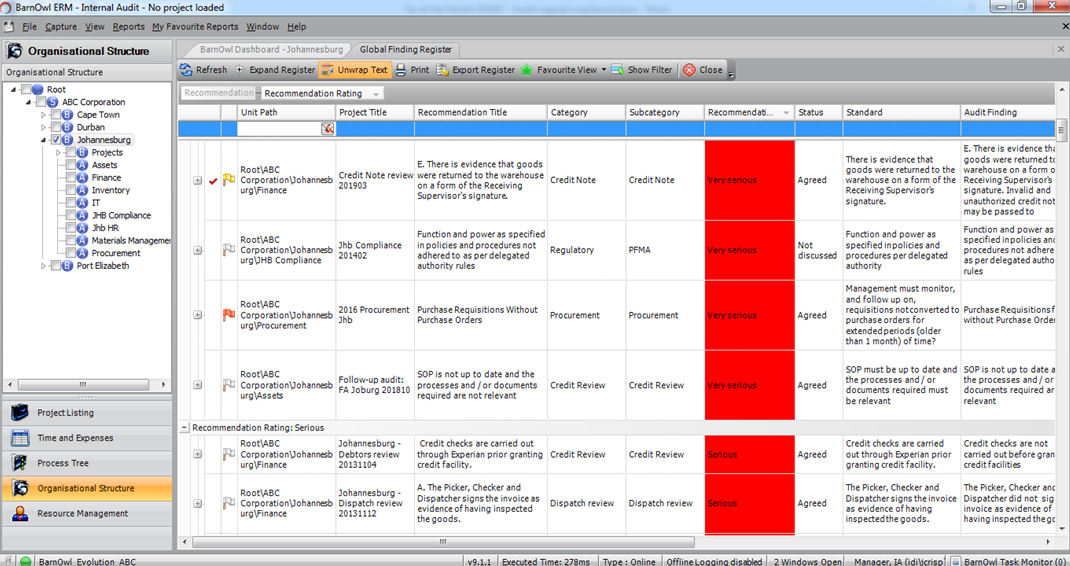
Process Tree navigation bar only
View > Scorecards > Process versus Unit Project Scorecard
This view enables you to rate processes / sub processes based on finding rules such as finding rating and repeat findings and showing open and overdue action plans as well as number of high risks:
Fig 8.1 View>Scorecards>Process versus Unit Project scorecard
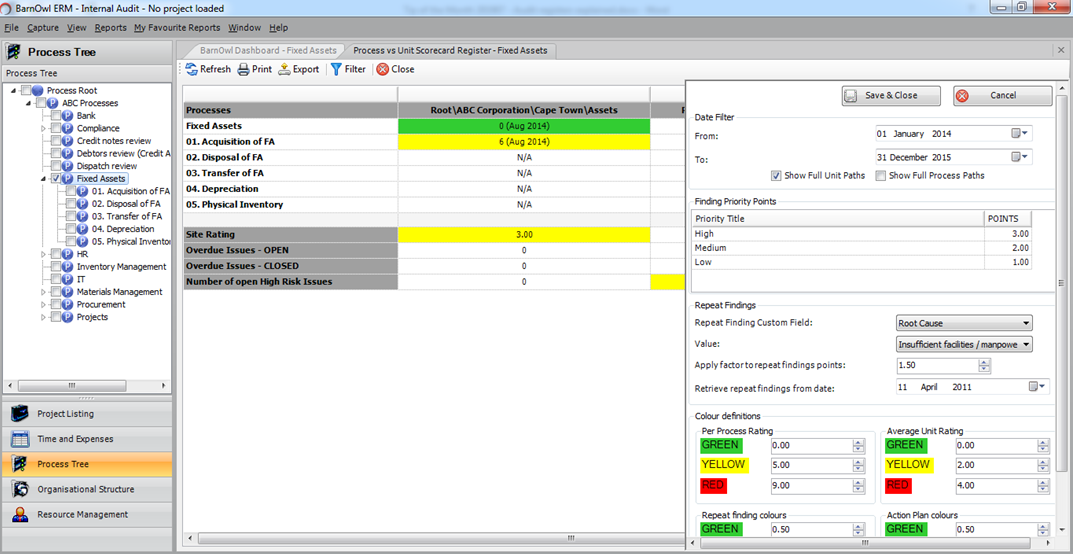
Project Listing, Process Tree and Organisational Structure navigation bars
View > Document Register
From the Project Listing navigation bar you are able to find and open all documents (in read-only mode) within projects:
Fig 9.1 View>Document Register
